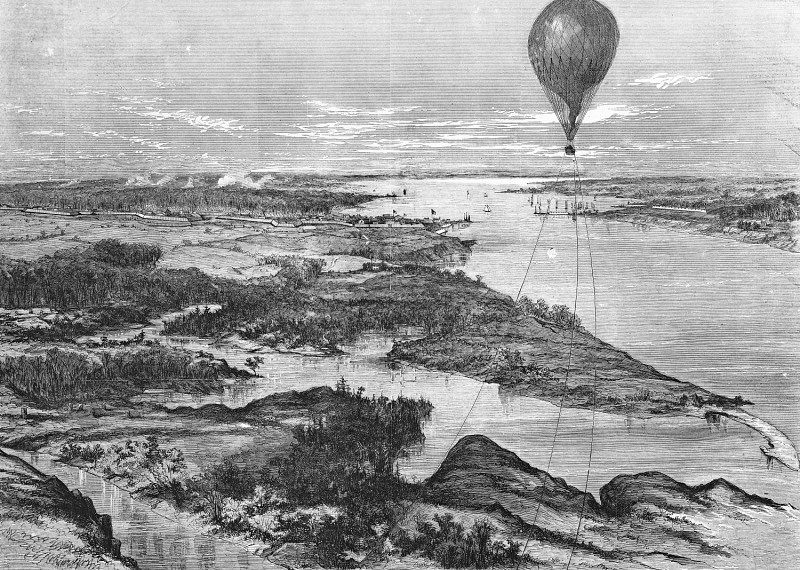
the first military aircraft in Virginia were balloons used in the Civil War
Source: Smithsonian Institution, National Air and Space Museum, LTA, Balloons, USA, Civil War; Lowe, Thaddeus Sobieski Constantine

the first military aircraft in Virginia were balloons used in the Civil War
Source: Smithsonian Institution, National Air and Space Museum, LTA, Balloons, USA, Civil War; Lowe, Thaddeus Sobieski Constantine
Military aviation has a long history in Virginia. Balloons floated above both Federal and Confederate lines. Spotters identified troop alignments and assisted in aiming artillery.
Today there are 11 airports in Virginia that are controlled by the military. The largest is Norfolk Naval Station (Chambers Field), which serves as the Air Cargo Transport Hub for the US Navy. Naval Air Station Oceana, home of five carrier air wings for the Atlantic Fleet, is the only Master Jet Base on the East Coast.
Marine Corps Base Quantico hosts the helicopter fleet for the White House. Fort Pickett supports Unmanned Aerial Systems (UAS) research and development.1
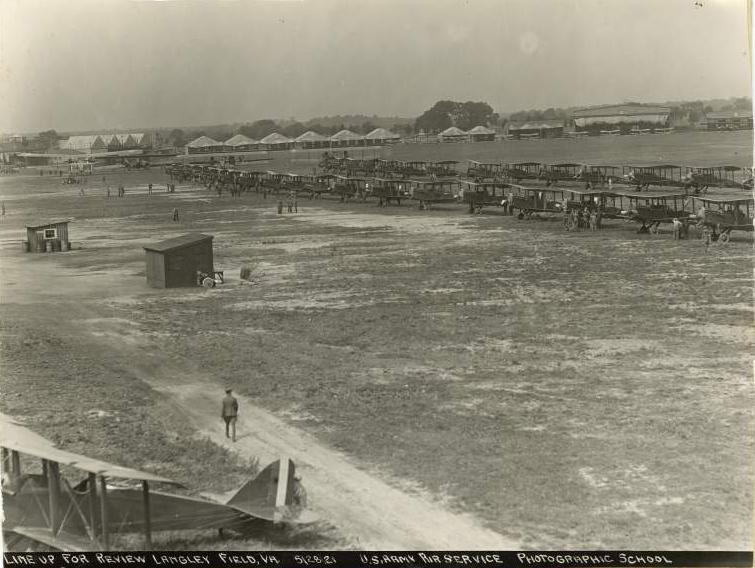
military air operations started early in Virginia, including Langley Field in 1916
Source: Smithsonian Institution, Military, USA, Army Air Service, Bases And Installations, Virginia, Langley Field
In 1908, the US military tested the new heavier-than-air invention of the Wright brothers at Ft. Myer. The first fatal aircraft accident in the US occurred there during a 1908 test, when Orville Wright was trying to convince the US Army to purchase planes produced by the Wright brothers.
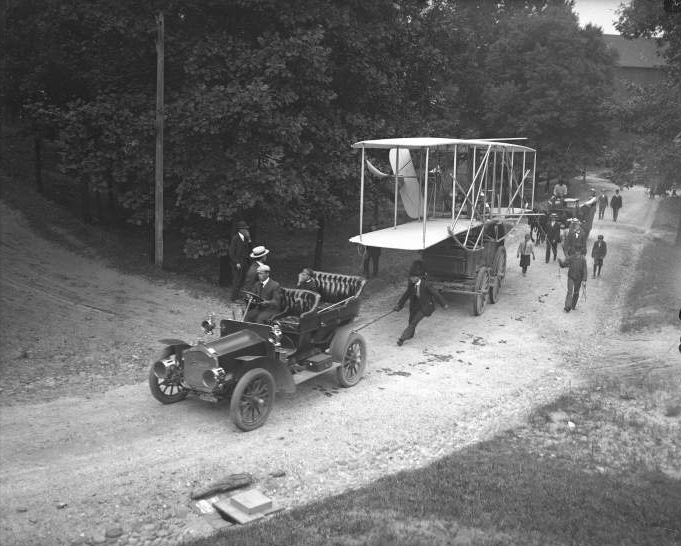
an automobile towed the Wright (Co) Type A Military biplane, with front struts and tail folded for transport, from the storage shed to the Ft. Myer airfield in 1908
Source: Smithsonian Institution, Events, 1908, Fort Myer (VA), Wright (Co) Type A Military Trials
The wire for the vertical rudder broke after four minutes of flight, when the plane was 150 feet above the ground. Orville Wright used his glider pilot skills to move the plane towards the landing strip, but at 90 feet the rudder shifted position. Wright managed to pull out of a steep dive at 20 feet, but the plane crashed hard. Wright's leg was broken and hips damaged, but he survived.
Lt. Thomas Selfridge died a day later from his injuries. Just before the flight, he had requested to take the place of a machinist on the Wright team who was scheduled to be the passenger. Selfridge was on the Army's Review Board, and Orville Wright accommodated the request of an official observer. It was the first time that a switch in places made by passengers on a flight was a fatal decision.2
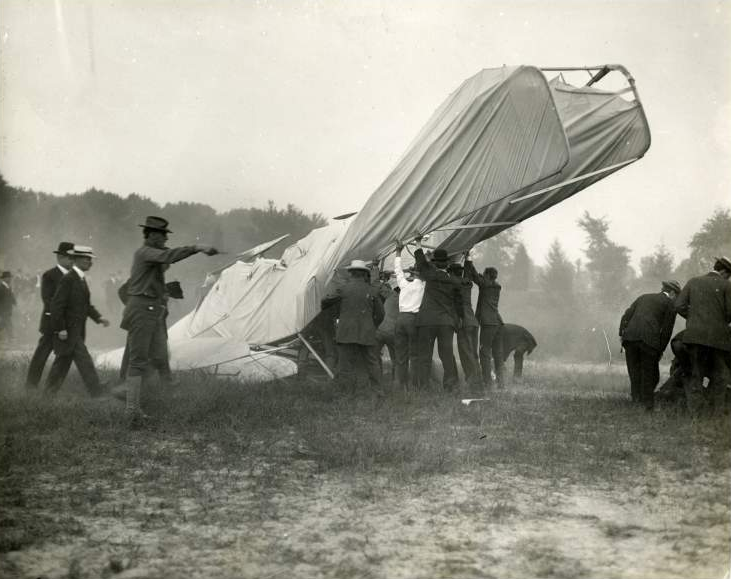
rescuers seek to extract Orville Wright from the wreckage, while others care for Lt. Thomas Selfridge (on right)
Source: Smithsonian Institution, .Aftermath of the crash of Orville Wright and Lt. Thomas O. Selfridge in the Wright Type A Military Flyer at Fort Myer, Virginia, September 17, 1908, during US Army flight trials
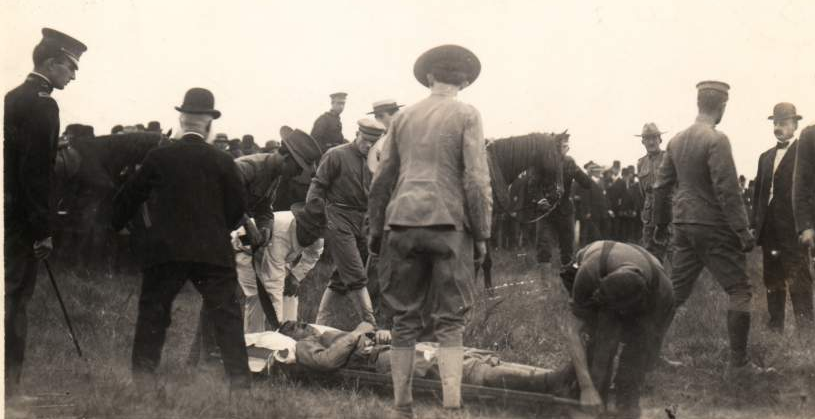
soldiers and civilians gather around Lt. Thomas Selfridge (on stretcher) after he was fatally injured in the crash of the Wright (Co) Type A Military biplane
Source: Smithsonian Institution, Events, 1908, Fort Myer (VA), Wright (Co) Type A Military Trials, Selfridge Crash
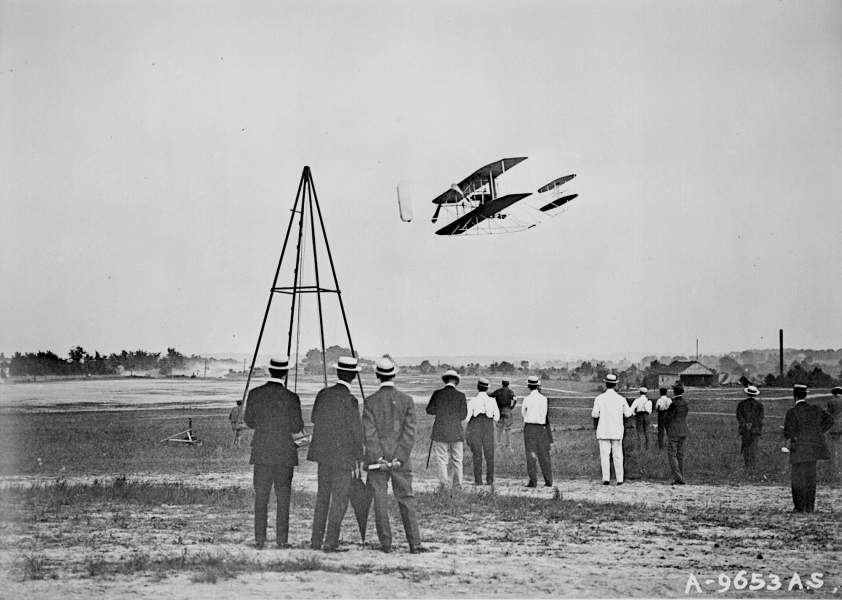
military testing of Wright-manufactured aircraft continued in 1909 at Fort Myer, after the death of Lt. Thomas Selfridge
Source: Smithsonian Institution, Wright 1909 Military Flyer in passing flight, one-quarter right rear view, Military Flight Trials, Fort Myer, Virginia, July 2, 1909
What is now Joint Base Langley-Eustis was the first place designed from scratch as a military airfield just before the United States entered World War I. The first ship designed as an aircraft carrier, the USS Langley, was created at the Norfolk Navy Yard from a ship that previously had carried coal. In 1922, it became the first ship to launch aircraft, and the first ship on which an aircraft landed successfully.3
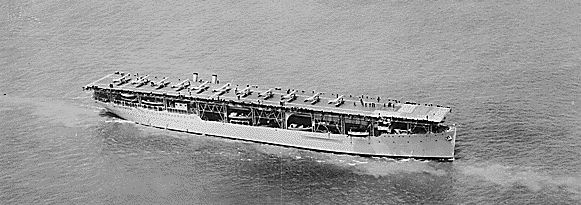
the USS Langley, created at the Norfolk Navy Yard from a former collier, became the first US aircraft carrier
Source: National Archives, US Navy Ships - Carriers, Langley Aerial, starboard bow, underway, aircraft on deck. 1927
Access to some airspace in Virginia is limited, to provide safe space for military operations and training as well as for base security. The Federal Aviation Administration has designated Military Operations Areas and restricted zones around military bases such as Naval Air Station Oceana and Fort Pickett.
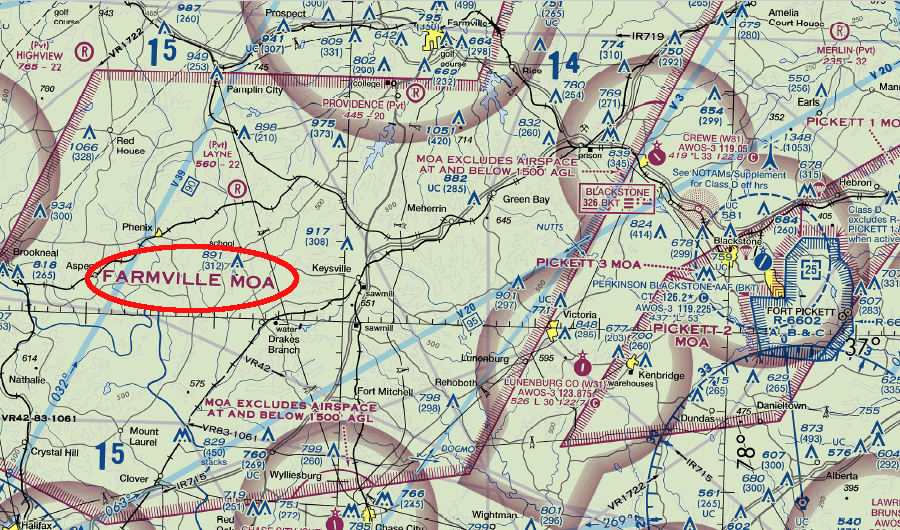
Military Operations Areas limit flights around military bases in Virginia
Source: Federal Aviation Administration, Visual Flight Rules (VFR) chart - Washington
After the terrorist attacks on 9/11 in which American Airlines Flight 77 was crashed into the Pentagon, the Federal Aviation Administration established the DC Special Flight Rules Area (SFRA, often called "Sifra"). Within the DC SFRA, a circle with a 30-mile radius, is a 15-mile radius Flight Restricted Zone (FRZ, often called "Freeze").
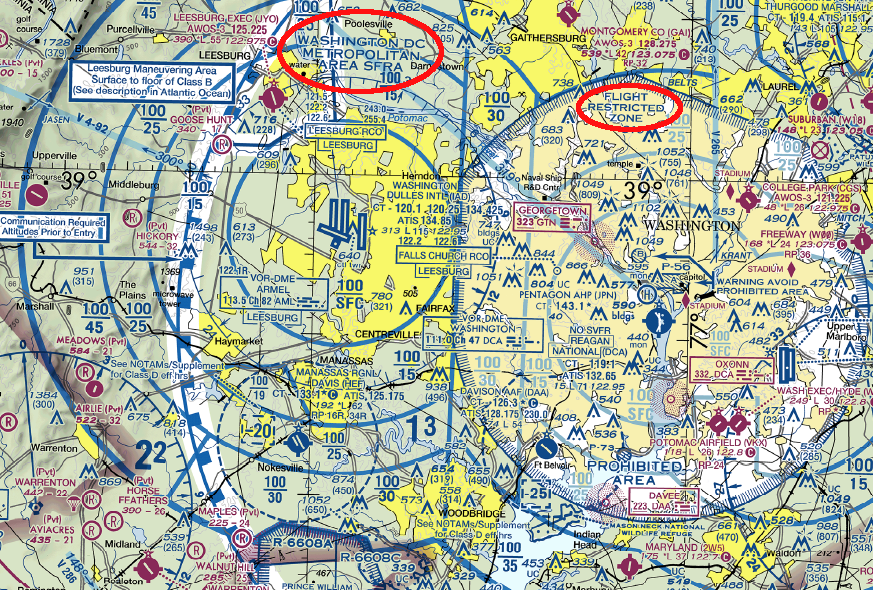
in Northern Virginia, pilots must pay special attention to the DC Special Flight Rules Area (SFRA) and Flight Restricted Zone (FRZ) within it
Source: Federal Aviation Administration, Visual Flight Rules (VFR) chart - Washington
The FAA designated the DC Special Flight Rules Area as National Defense Airspace. The Federal government announces to pilots through various channels that it may use deadly force against aircraft that do not follow special procedures, including requirements for special flight plans, use of communication frequencies, and limits on aircraft speed.
Pilots are required to complete special training on flight operations before going into the DC Special Flight Rules Area. The intent is to provide adequate warning time for military aircraft to identify potential threats and intercept, if necessary.4
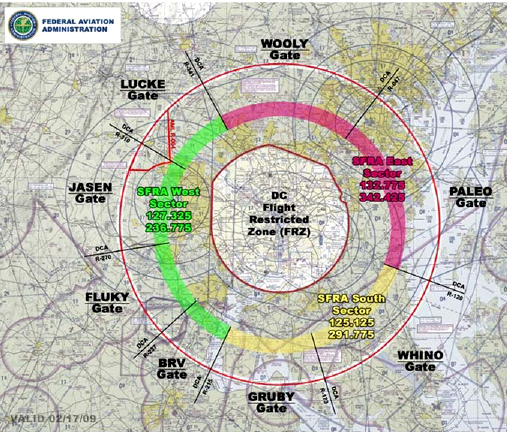
in Northern Virginia, pilots use designated "gates" to enter or exit the DC Special Flight Rules Area (SFRA)
Source: Federal Aviation Administration, Special
Flight. Rules Area (SFRA) Course Notes
On January 1, 2011, pilots of a Piedmont Airlines commercial airliner flying from South Carolina tuned their radio to the wrong frequency while approaching Reagan National Airport (DCA). The "Aircon Red" alert, issued after the plane entered the DC Special Flight Rules Area without communicating as required to air traffic controllers, triggered an e-mail directing all staffers on Capitol Hill to evacuate the buildings.
F-16 fighters took off from Andrews Air Force Base when the apparently-unauthorized aircraft entered the restricted airspace. The Piedmont Airlines pilots switched to the correct frequency before the jets spotted the commercial flight, but the incident demonstrated the potential of the US Air Force shooting down a commercial plane within the Flight Restricted Zone.5
Every four years on January 20, the airspace is further restricted during the presidential inauguration events. Pre-scheduled General Aviation flights may continue to use only Manassas Regional Airport (HEF), Dulles International Airport (IAD), and Baltimore Washington International Airport (BWI) during presidential inaugurations. General Aviation flights seeking to to transit through the DC Special Flight Rules Area or use Leesburg (JYO), Quantico (NYG), and airports in Maryland are constrained.6

pre-scheduled General Aviation flights may continue to use only Manassas Regional Airport (HEF), Dulles International Airport (IAD), and Baltimore Washington International Airport (BWI) during presidential inaugurations
Source: Federal Aviation Administration, Flight Advisory National Special Security Event 2017 Presidential Inauguration Festivities
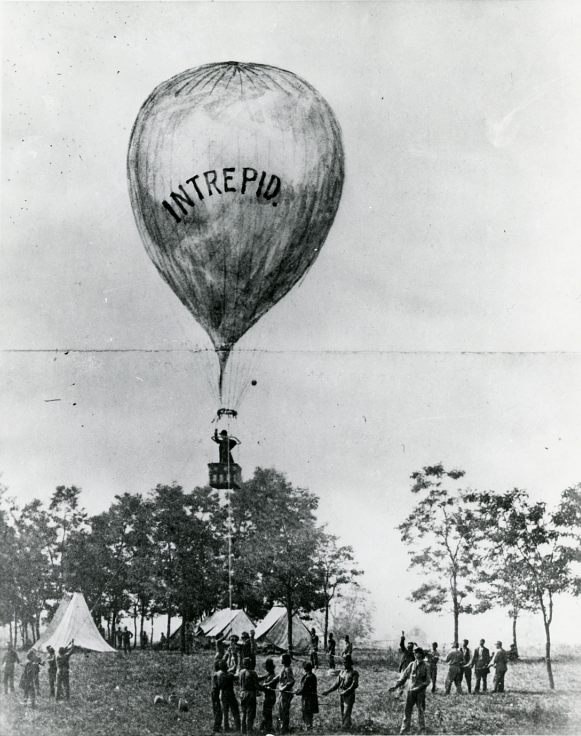
during the Peninsular Campaign in the Civil War, the Federal army used the balloon Intrepid to assess the Confederate army's position
Source: Smithsonian Institution, Thaddeus Lowe's Balloon Ascent
1. "Browse Airports - Virginia," Air.Nav, http://www.airnav.com/airports/us/VA?use=M; "Competitive Analysis of Virginia's Aviation Industry," Virginia Department of Aviation, January 2012, pp.9-10, http://doav.virginia.gov/Downloads/Studies/Competitive%20Analysis/DOAVAviationCompetitiveAnalysisRevised.pdf (last checked December 31, 2016)
2. Linda Burdette, "The Wright Brothers' Historic Flying Demonstration at Fort Myers," Virginia Aviation History Project, July 2008, http://virginiaaviationhistory.org/wp-content/uploads/2015/06/The-Wright-Brothers-History-Flying-Demonstration-at-Fort-Myers.pdf (last checked December 30, 2016)
3. "Langley Field's founders envisioned an air power center like no other," Daily Press, April 18, 2016, http://www.dailypress.com/news/military/langley100/dp-langley-centennial-founding-20160417-story.html; "America's First Aircraft Carrier - USS Langley (CV 1)," Naval History blog, US Naval Institute, March 20, 2014 , https://www.navalhistory.org/2014/03/20/americas-first-aircraft-carrier-uss-langley-cv-1-warfighting-first-platforms-people
(last checked December 27, 2016)
4. "DC Special Flight Rules Area," Federal Aviation Administration, https://www.faasafety.gov/gslac/ALC/CourseLanding.aspx?cID=405 (last checked December 30, 2016)
5. "Stray airliner prompts Hill evacuation," Politico, January 1, 2011, http://www.politico.com/story/2011/01/stray-airliner-prompts-hill-evacuation-046937 (last checked December 30, 2016)
6. "Flight Advisory National Special Security Event 2017 Presidential Inauguration Festivities," Federal Aviation Administration, December, 2016, https://www.faasafety.gov/files/notices/2016/Dec/2017_Inauguration_Advisory.pdf (last checked December 30, 2016)
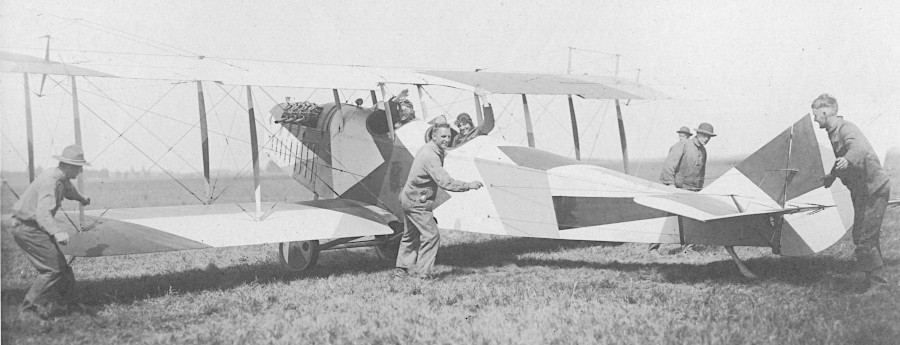
taking off at Langley in 1917-18
Source: National Archives, Curtiss JN-4 taking off, at Langley Field, Virginia
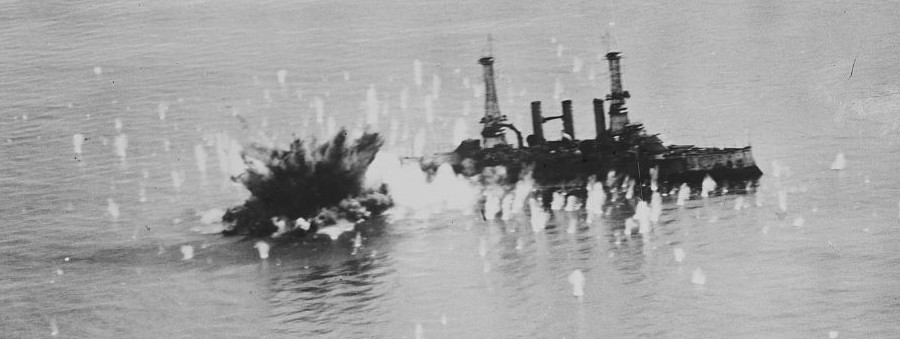
General Billy Mitchell demonstrated the power of aerial bombing in 1923 by destroying an obsolete battleship, USS Virginia (BB-13)
Source: Library of Congress, Bombing VIRGINIA